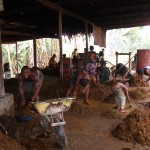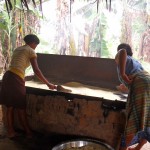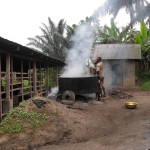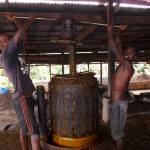Palm Oil Processing 101
Palm oil processing is part of everyday life here in southeast Nigeria. Every community has countless palm trees giving the landscape a picturesquely tropical look, while the not-so-pleasant scent of palm fruit cooking is never far away. The process of turning palm fruit from the oil palm tree into crude palm oil for consumption is not only an important end product and key ingredient in many local dishes, but it is also an income generating activity that enables many women, as well as some men and youth, to earn additional finances to support their families. Nigeria is currently the third largest producer of palm oil, but consumes more crude oil than it produces leading to the importation of additional oil from other countries. The oil produced from both the palm fruit and palm kernels have many other uses as well, including cosmetics and as an ingredient in processed foods.
One of the key components of the Mary Slessor Foundation (MSF) is the agricultural processing facility we operate for the community that provides the equipment, facility, and extra labor needed in the highly laborious process of turning palm fruit into crude oil, as well as the equipment for cracking kernels to be sold to traders and for processing cassava into garri, a staple food in the local diet. Currently, during the high season, we employ a manager (Nte) and three additional staff (Akong, Asuquo, and Emmanuel) and serve over twenty-five direct customers and their families. Our equipment is semi-mechanized, though many steps in the process are manual. A benefit of our integrated NGO model is that every department supports each other in the development of the organization and community. When a piece of equipment in the mill needs servicing, trainees from the Mechanical Engineering & Metal Welding department at the MSF Vocational Training Center will come have a look and repair the equipment promptly under the supervision and with guidance from their instructors.
For those of you who are not familiar with the process, I’ve outlined the main steps below as an introduction.
Palm oil processing:
- Step 1 – Fruit bunch reception
- Step 2 – Threshing (This means removing the fruit from the bunches they come off of on the tree.)
- Step 3 – Cooking fruit (The fruit is cooked in big metal pots to soften the fruit in preparation for processing.)
- Step 4 – Digestion (A mechanized step that uses a generator to power the machine that pounds the palm fruit to soften the inner layer of the fruit in preparation for the oil extraction.)
- Step 5 – Pressing (This is the process of extracting the oil from the fruit.)
- Step 6 – Fibre-nut separation (A manual step, typically undertaken by elderly women, that involves using a hand tool to remove the fibre from the nut of the palm fruit.)
- Step 7 – Nut drying (You’ll see piles of palm nuts sitting out to dry around our mill.)
- Step 8 – Kernel cracking (The final step that we facilitate here, this is also a mechanized generator-powered step in which the nuts are cracked into small pieces. These are sold to traders from Calabar town and Akwa Ibom State who will take them on for further processing into palm kernel oil.)
1. Nte (MSF mill manager) cooking palm fruit.
2. Emmanuel & Asuquo working hard on the presser.
3. Community members and customers work together to separate the fiber from the nut.
4. Women cooking garri at the MSF facility.




